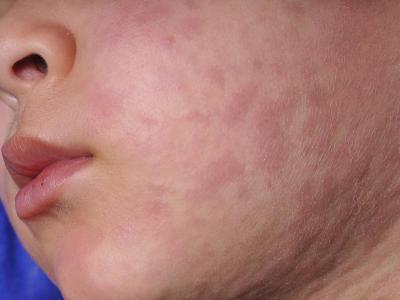Oct 13, 2011 (CIDRAP News) – A field trial in young children that compared an adjuvanted version of the seasonal flu vaccine with the conventional, non-adjuvanted version during two flu seasons found promising results for the boosted version, which might open up new options for a more effective vaccine strategy, researchers reported today.
The phase 3 trial of the oil-in-water MF59 vaccine, funded and conducted by Novartis, appears in today's issue of the New England Journal of Medicine. Researchers used polymerase chain reaction (PCR)–confirmed flu to gauge the efficacy of the vaccines. The adjuvant has been used in some seasonal flu vaccines for older adults since 1997 and is licensed in 27 countries, though not in the United States.
Influenza experts commenting on the study called it well designed but pointed out that it covers only one season in which a single flu strain dominated, and that further studies will be necessary to validate the findings.
Though children have the highest rates of flu infections, evidence for the efficacy of the inactivated seasonal vaccine is limited in children younger than 2 years old. Clinicians sometimes have a tough time determining the best way to protect the youngest kids from seasonal flu, because even though the live attenuated influenza vaccine (LAIV) offers better protection than trivalent inactivated vaccine (TIV) in children, it can't be used in kids younger than 2 years of age or in those under age 5 who have a history of wheezing.
Researchers tested the vaccines during the 2007-08 flu season in 654 German children and during the 2008-09 season in 4,053 German and Finnish children. The kids were healthy and had not previously received a flu vaccine. Researchers stratified them by two age-groups: 6 months to younger than 36 months and 3 years to younger than 6 years.
The study was also designed to assess the safety of the adjuvanted vaccine when compared with TIV.
During the first year, volunteers were randomized to receive the adjuvanted vaccine, a subunit TIV, or a control vaccine, a meningococcal vaccine for kids ages 6 to 12 months or a tickborne encephalitis vaccine for children ages 12 months to age 7. During the second year, the children were randomized to receive the adjuvanted vaccine, split-virus TIV, and the control vaccine. They received two doses, 28 days apart.
Starting 3 weeks after kids received the second dose of vaccine, parents were asked to bring their children for assessment and testing if they got sick during the flu seasons.
During the first year, only five influenza infections were confirmed in vaccinated children, of which three involved mismatched influenza B viruses, so researchers did not calculate vaccine efficacy for that flu season.
In the second year of the study, 105 isolates were positive for influenza, and 94 were the influenza A (H3N2) strain. The rest included 5 mismatched influenza B samples, 4 unsubtyped influenza A, and 2 unsubtyped influenza B. No seasonal H1N1 viruses were detected.
Investigators found that adjuvanted flu vaccine was more effective than TIV. The absolute vaccine efficacy against all flu strains for the adjuvanted vaccine was 86% (95% confidence interval [CI], 74%-93%), compared with 43% (95% CI, 15%-61%) for TIV. Relative efficacy was 75% (95% CI, 55%-87%).
In the youngest age-group, the efficacy for the adjuvanted vaccine was 79% (95% CI, 55%-90%), and for the older age-group it was 92% (95% CI, 77%-97%). TIV efficacy for the younger group was 40% (95% CI, -6%- 66%) and 45% for the older children (95% CI, 6%-68%).
Safety data were available for 4,692 of the children, and rates of systemic and local reactions were similar for both vaccines in the younger age-group, but systemic effects such as mild fever were more common among older children who receive the adjuvanted vaccine (63%), than TIV (44%), or the control (50%). Serious adverse events were distributed evenly across the groups, according to the study.
When the researchers analyzed immunogenicity data from 793 Finnish children during the second year of the study, they found that after one dose of adjuvanted vaccine, seroprotection rates, signified by a hemagglutination inhibition antibody titer of 40 or more, for the younger group was 92% and 95% for H1N1 and H3N2 strains, respectively. For the same age-group, seroprotection for TIV against the two strains was 20% and 12%, respectively.
For the older group, seroprotection levels from one dose of adjuvanted vaccine were 100% and 97%, compared with 63% and 60% for TIV.
Researchers also found that seroprotection from the adjuvanted vaccine was long lasting, with 98% to 100% still having seroprotection titers at day 181, compared with 49% and 65% of those who got TIV.
Though the results showed that the adjuvanted flu vaccine was more effective against lab-confirmed flu, the researchers pointed out that most of the study results were from year 2, when nearly all of the samples were H3N2, so they were unable to meaningfully assess the efficacy of the two vaccines against influenza B or H1N1.
However, they noted that the immunological part of the study found that although seroprotection thresholds for those who received two doses of adjuvanted vaccine were somewhat lower for influenza B than influenza A, the level was still higher than in kids who received TIV.
"Low responses to the B strain in children are of particular concern, since this age group has a disproportionate share of influenza B virus infections," they wrote, adding that B strains are often responsible for late-season flu outbreaks, and long-lasting protection could be another advantage of the adjuvanted vaccine compared with TIV.
The authors noted that the modest efficacy they found for TIV (45%) against matched flu strains is similar to other studies' results. For comparison, the efficacy of LAIV in children ages 6 months to 7 years is about 78%, they write.
Edward Belongia, MD, director of the Epidemiology Research Center at the Marshfield Clinic Research Foundation in Marshfield, Wis., told CIDRAP News that the study is a well-designed randomized controlled trial that used PCR-confirmed flu as the outcome.
He said he's not aware of any other studies that have done a head-to-head comparison of the two vaccines and that although the 43% efficacy finding for TIV isn't surprising, the trial is helpful, because it provides useful information about it, as well as the adjuvanted version.
Though researchers found a boost for the adjuvanted vaccine, nearly double that of TIV, there are still unanswered questions about its safety, Belongia said, adding that the findings are likely to stimulate some debate about the risks and benefits of adjuvanted vaccines. "You can't answer that in a single season," he said.
"This could heat up the debate a bit. What additional safety data are needed, and how do we get it," Belongia said. He noted that the efficacy of LAIV is close to that of the adjuvanted vaccine, but without the same safety concerns.
Dr Heath Kelly, head of the Epidemiology Unit at the Victoria Infectious Disease Reference Laboratory in North Melbourne, Australia, told CIDRAP News that one lesson from the study is that a disease that is usually common in children is not always common.
"The difference in the two seasons illustrates one of the problems confronting public health policy makers, namely the interpretation of the 'average influenza season.' and the assessment of benefits during that average season," he said.
The early data about the increase in relative efficacy of the adjuvanted vaccine is encouraging, though the analysis was mainly confined to H3N2 in one season, Kelly said, adding that the findings about its seroprotection after one dose and length of protection after two doses were also promising. "However, these data all need to be confirmed in other seasons and against influenza B and A (H1N1)," he said.
If the higher efficacy is confirmed and the safety profile is acceptable, the adjuvanted vaccine could have an impact on influenza vaccination policy for children, Kelly said.
"In the last few years many investigators have called for improved influenza vaccines—and not just for children. The study reported here is an encouraging move towards improved vaccines," he said.
Vesikari T, Knuf M, Wutzler P, et al. Oil-in-water adjuvant with influenza vaccine in children. N Engl J Med 2011 Oct 13;365(15):1406-16 [Abstract]

















